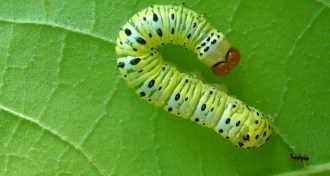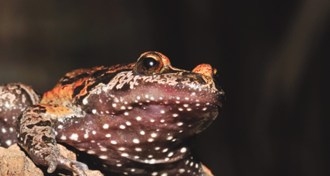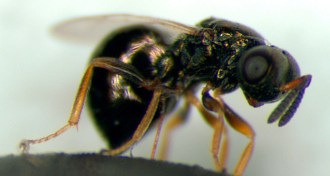Search Results for: Ants
Skip to resultsCan’t find what you’re looking for? Visit our FAQ page.
1,662 results for: Ants
-
 Animals
AnimalsMeat-Eating Caterpillar: It hunts snails and ties them down
A newly named species of Hawaiian caterpillar sneaks up on a resting snail and quickly spins silk strands around it, lashing it to the spot, and then eats it.
By Susan Milius -
 Plants
PlantsIn dry times, these trees invest in ants
The insects provide adequate defense by ganging up on leaf-eating caterpillars and biting their undersides until the herbivores fall off the tree.
-
 Animals
AnimalsA year of rediscovered species
Thousands of species go extinct each year, but at least a few are found after many years of being lost.
-
 Animals
AnimalsSkin Scam: Parasite’s host provides an insect hideaway
A group of parasitic insects called Strepsiptera can hide inside their victim by making the host form a protective bag of its own skin.
By Susan Milius -
 Animals
AnimalsSumo wrestling keeps big ants in line
In a Malaysian ant species, the large workers establish a hierarchy by engaging in spectacular shaking contests.
By Susan Milius -
 Animals
AnimalsTo Bee He or She: Honeybees use novel sex-setting switch
After more than a decade of work, an international team has found the main gene that separates the girls from the boys among honeybees.
By Susan Milius -
 Animals
AnimalsSkin Chemistry: Poison frogs upgrade toxins from prey
For the first time, scientists have found a poisonous frog that takes up a toxin from its prey and then tweaks the chemical to make it a more deadly weapon.
By Susan Milius -
 Ecosystems
EcosystemsNew Farmers: Salt marsh snails plow leaves, fertilize fungus
A salt marsh snail works the leaves of a plant in what researchers say looks like a simple form of farming.
By Susan Milius -
 Animals
AnimalsGut microbes may put barrier between species
Wiping out gut bacteria in wasps saves crossbred offspring from death, suggesting that microbes may play a role in speciation.
By Susan Milius -
 Humans
HumansFrom the April 19, 1930, issue
TRAVEL TO THE MOON BY THE YEAR 2050 By the year 2050, Earth-dwellers will probably be able to travel to the moon and to communicate with their terrestrial home by telephoning over a beam of light. They will get there by traveling in a rocket ship at a speed of some 50,000 miles an hour, […]
By Science News -

Bug Watching
Crazy about insects? The Sonoran Arthropod Studies Institute in Arizona has a “Backyard Bugwatching” page with links to photos and articles focusing on a variety of insects and their diverse habitats. Learn what it takes to track Mexican leaf-cutter ants and catch bullet ants. Journey to Costa Rica’s rainforests for close-ups of novel arthropods. Watch […]
By Science News -
 Ecosystems
EcosystemsNomadic ants hunt mushrooms
A species of ants not well understood surprises researchers with a nomadic lifestyle, roaming the rainforest on fungal forays.
By Susan Milius